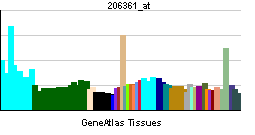GPR44
Jump to navigation
Jump to search
| G protein-coupled receptor 44 | |||||||||||
|---|---|---|---|---|---|---|---|---|---|---|---|
| Identifiers | |||||||||||
| Symbols | GPR44 ; CD294; CRTH2 | ||||||||||
| External IDs | Template:OMIM5 Template:MGI HomoloGene: 3508 | ||||||||||
| |||||||||||
| RNA expression pattern | |||||||||||
 | |||||||||||
 | |||||||||||
| More reference expression data | |||||||||||
| Orthologs | |||||||||||
| Template:GNF Ortholog box | |||||||||||
| Species | Human | Mouse | |||||||||
| Entrez | n/a | n/a | |||||||||
| Ensembl | n/a | n/a | |||||||||
| UniProt | n/a | n/a | |||||||||
| RefSeq (mRNA) | n/a | n/a | |||||||||
| RefSeq (protein) | n/a | n/a | |||||||||
| Location (UCSC) | n/a | n/a | |||||||||
| PubMed search | n/a | n/a | |||||||||
G protein-coupled receptor 44, also known as GPR44, is a human gene.[1] GPR44 has also been designated as CD294 (cluster of differentiation 294).
G protein-coupled receptors (GPCRs), such as GPR44, are integral membrane proteins containing 7 putative transmembrane domains (TMs). These proteins mediate signals to the interior of the cell via activation of heterotrimeric G proteins that in turn activate various effector proteins, ultimately resulting in a physiologic response.[supplied by OMIM][1]
References
Further reading
- Nagata K (2004). "CRTH2". J. Biol. Regul. Homeost. Agents. 17 (4): 334–7. PMID 15065763.
- Chiba T, Kanda A, Ueki S; et al. (2007). "Possible novel receptor for PGD2 on human bronchial epithelial cells". Int. Arch. Allergy Immunol. 143 Suppl 1: 23–7. doi:10.1159/000101400. PMID 17541272.
- Nagata K, Tanaka K, Ogawa K; et al. (1999). "Selective expression of a novel surface molecule by human Th2 cells in vivo". J. Immunol. 162 (3): 1278–86. PMID 9973380.
- Marchese A, Sawzdargo M, Nguyen T; et al. (1999). "Discovery of three novel orphan G-protein-coupled receptors". Genomics. 56 (1): 12–21. doi:10.1006/geno.1998.5655. PMID 10036181.
- Hirai H, Tanaka K, Yoshie O; et al. (2001). "Prostaglandin D2 selectively induces chemotaxis in T helper type 2 cells, eosinophils, and basophils via seven-transmembrane receptor CRTH2". J. Exp. Med. 193 (2): 255–61. PMID 11208866.
- Hirai H, Tanaka K, Takano S; et al. (2002). "Cutting edge: agonistic effect of indomethacin on a prostaglandin D2 receptor, CRTH2". J. Immunol. 168 (3): 981–5. PMID 11801628.
- Iwasaki M, Nagata K, Takano S; et al. (2002). "Association of a new-type prostaglandin D2 receptor CRTH2 with circulating T helper 2 cells in patients with atopic dermatitis". J. Invest. Dermatol. 119 (3): 609–16. doi:10.1046/j.1523-1747.2002.01862.x. PMID 12230502.
- Strausberg RL, Feingold EA, Grouse LH; et al. (2003). "Generation and initial analysis of more than 15,000 full-length human and mouse cDNA sequences". Proc. Natl. Acad. Sci. U.S.A. 99 (26): 16899–903. doi:10.1073/pnas.242603899. PMID 12477932.
- Böhm E, Sturm GJ, Weiglhofer I; et al. (2004). "11-Dehydro-thromboxane B2, a stable thromboxane metabolite, is a full agonist of chemoattractant receptor-homologous molecule expressed on TH2 cells (CRTH2) in human eosinophils and basophils". J. Biol. Chem. 279 (9): 7663–70. doi:10.1074/jbc.M310270200. PMID 14668348.
- Huang JL, Gao PS, Mathias RA; et al. (2005). "Sequence variants of the gene encoding chemoattractant receptor expressed on Th2 cells (CRTH2) are associated with asthma and differentially influence mRNA stability". Hum. Mol. Genet. 13 (21): 2691–7. doi:10.1093/hmg/ddh279. PMID 15345705.
- Gerhard DS, Wagner L, Feingold EA; et al. (2004). "The status, quality, and expansion of the NIH full-length cDNA project: the Mammalian Gene Collection (MGC)". Genome Res. 14 (10B): 2121–7. doi:10.1101/gr.2596504. PMID 15489334.
- Venet F, Lepape A, Debard AL; et al. (2004). "The Th2 response as monitored by CRTH2 or CCR3 expression is severely decreased during septic shock". Clin. Immunol. 113 (3): 278–84. doi:10.1016/j.clim.2004.07.005. PMID 15507393.
- Gazi L, Gyles S, Rose J; et al. (2005). "Delta12-prostaglandin D2 is a potent and selective CRTH2 receptor agonist and causes activation of human eosinophils and Th2 lymphocytes". Prostaglandins Other Lipid Mediat. 75 (1–4): 153–67. PMID 15789622.
- Hata AN, Lybrand TP, Breyer RM (2005). "Identification of determinants of ligand binding affinity and selectivity in the prostaglandin D2 receptor CRTH2". J. Biol. Chem. 280 (37): 32442–51. doi:10.1074/jbc.M502563200. PMID 16030019.
- Sandig H, Andrew D, Barnes AA; et al. (2006). "9alpha,11beta-PGF2 and its stereoisomer PGF2alpha are novel agonists of the chemoattractant receptor, CRTH2". FEBS Lett. 580 (2): 373–9. doi:10.1016/j.febslet.2005.11.052. PMID 16378605.
- Schratl P, Royer JF, Kostenis E; et al. (2007). "The role of the prostaglandin D2 receptor, DP, in eosinophil trafficking". J. Immunol. 179 (7): 4792–9. PMID 17878378.
External links
- GPR44+protein,+human at the US National Library of Medicine Medical Subject Headings (MeSH)
| Stub icon | This membrane protein–related article is a stub. You can help Wikipedia by expanding it. |
This article incorporates text from the United States National Library of Medicine, which is in the public domain.